高中英语必修4 Unit 4 Body language Reading 课件(共37张ppt)
文档属性
| 名称 | 高中英语必修4 Unit 4 Body language Reading 课件(共37张ppt) | 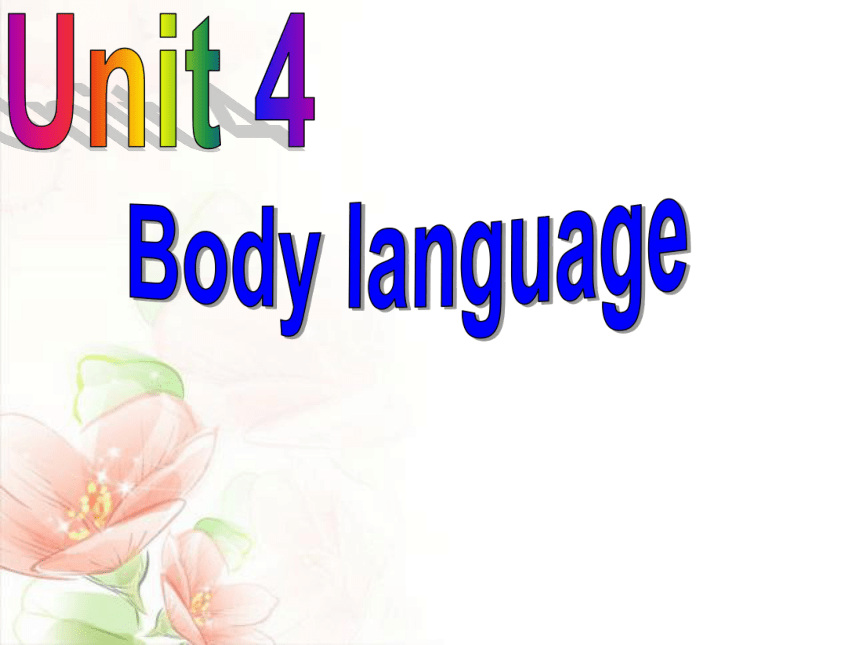 | |
| 格式 | zip | ||
| 文件大小 | 3.2MB | ||
| 资源类型 | 教案 | ||
| 版本资源 | 人教版(新课程标准) | ||
| 科目 | 英语 | ||
| 更新时间 | 2020-04-16 12:07:22 | ||
图片预览


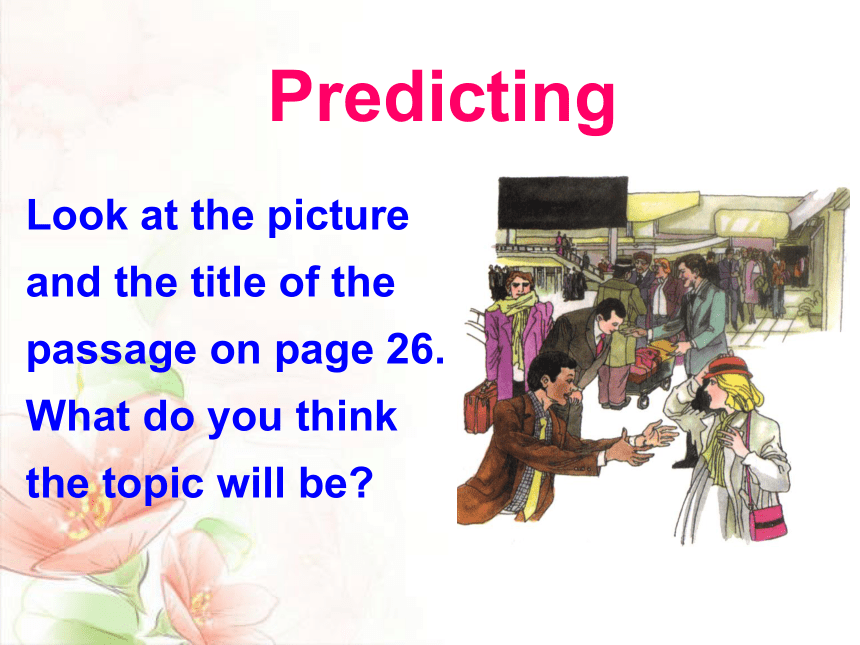
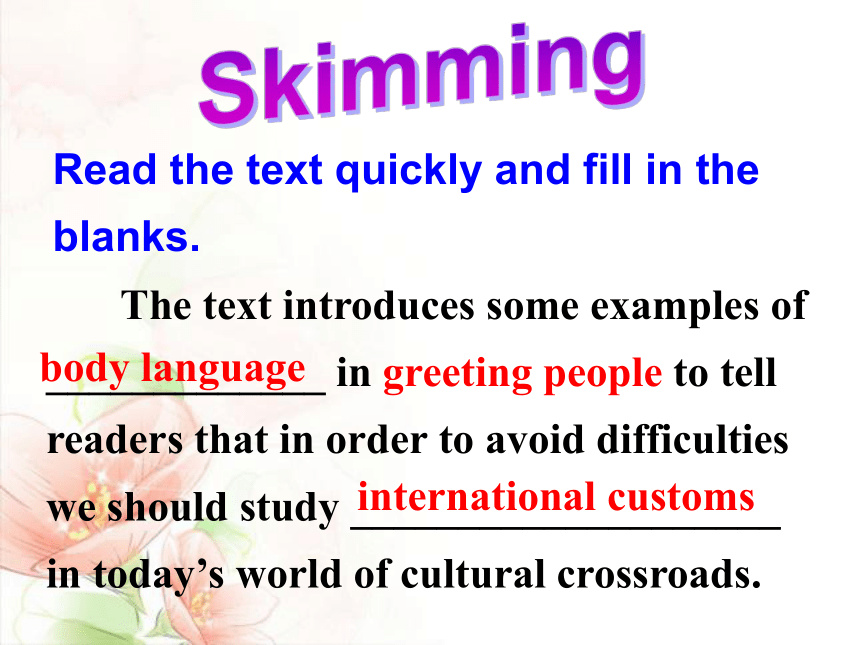
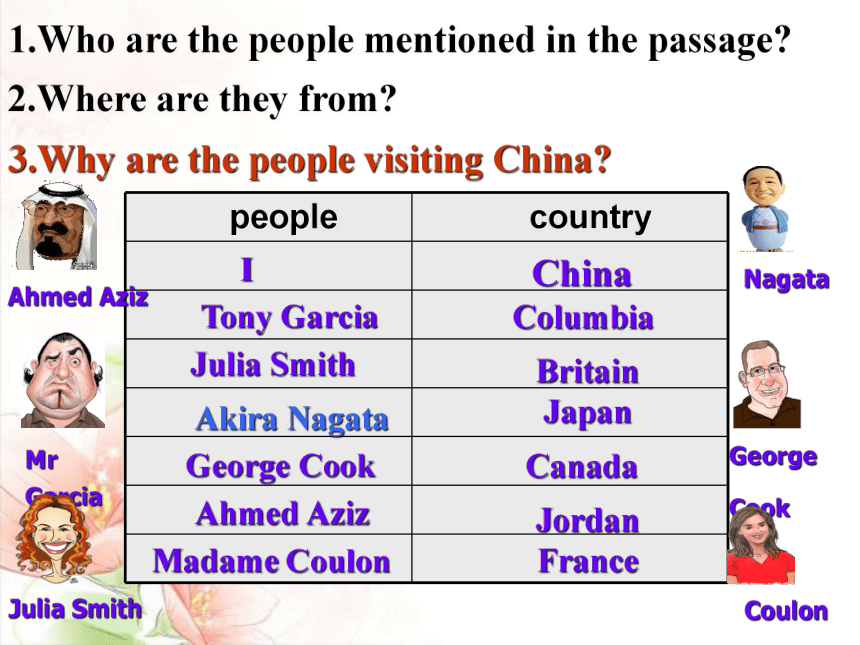
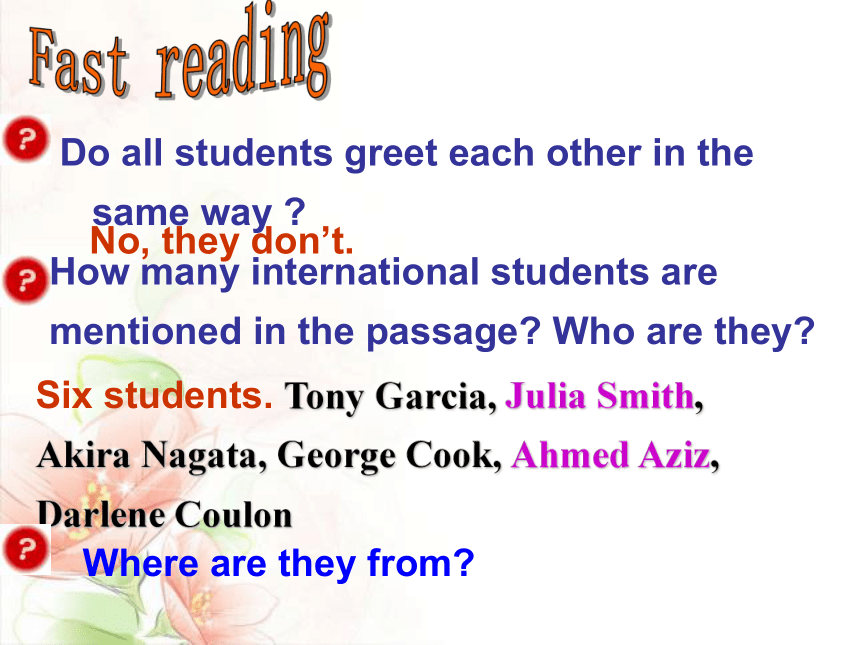
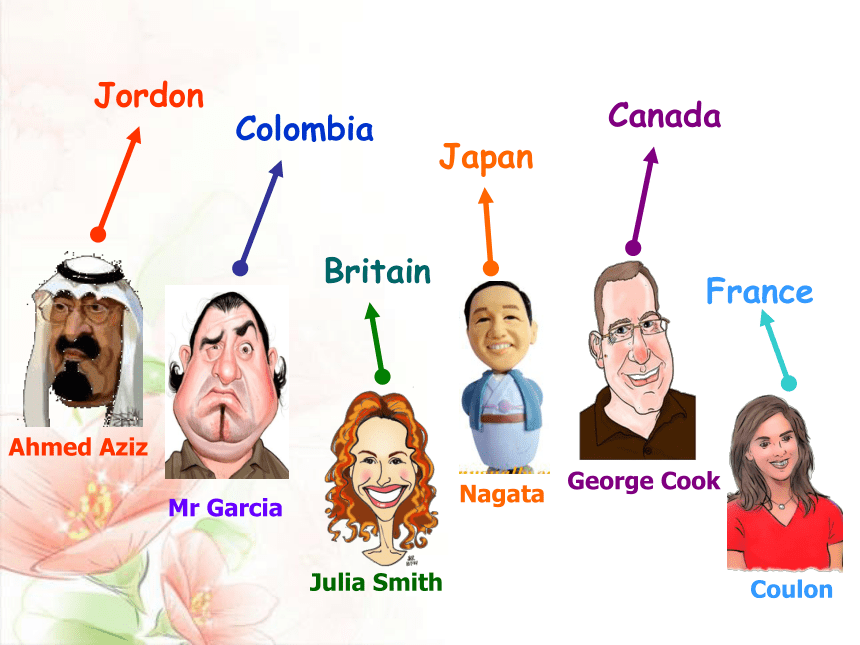

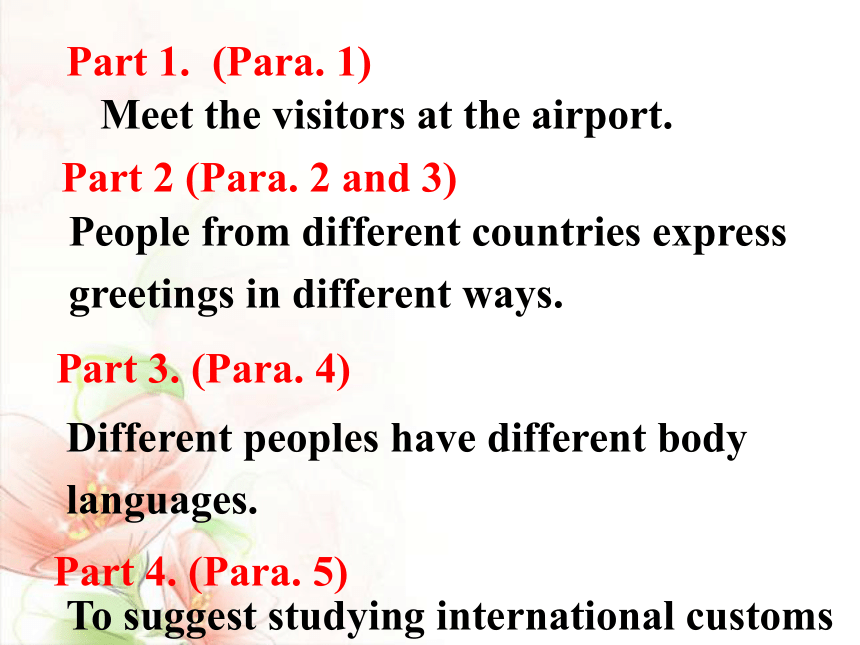
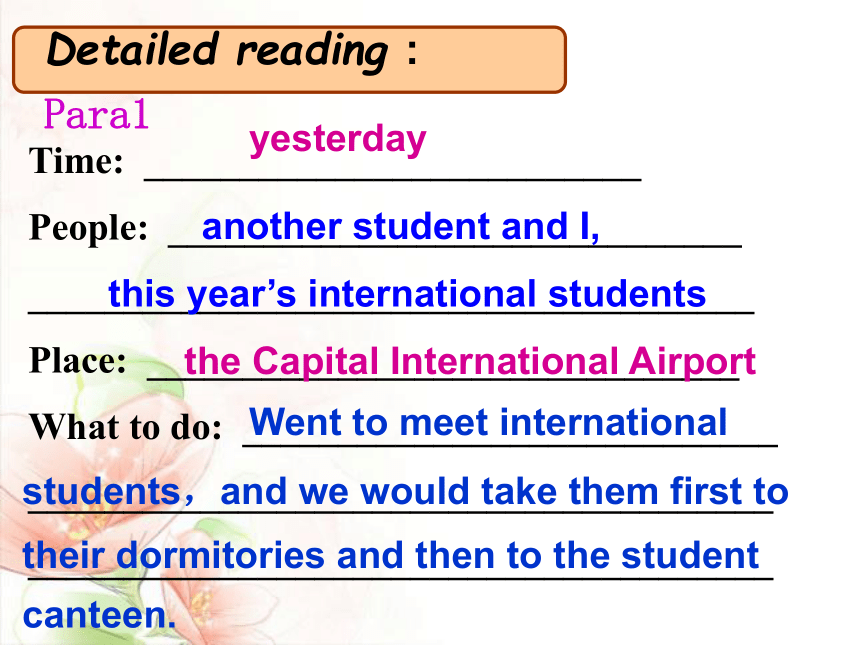
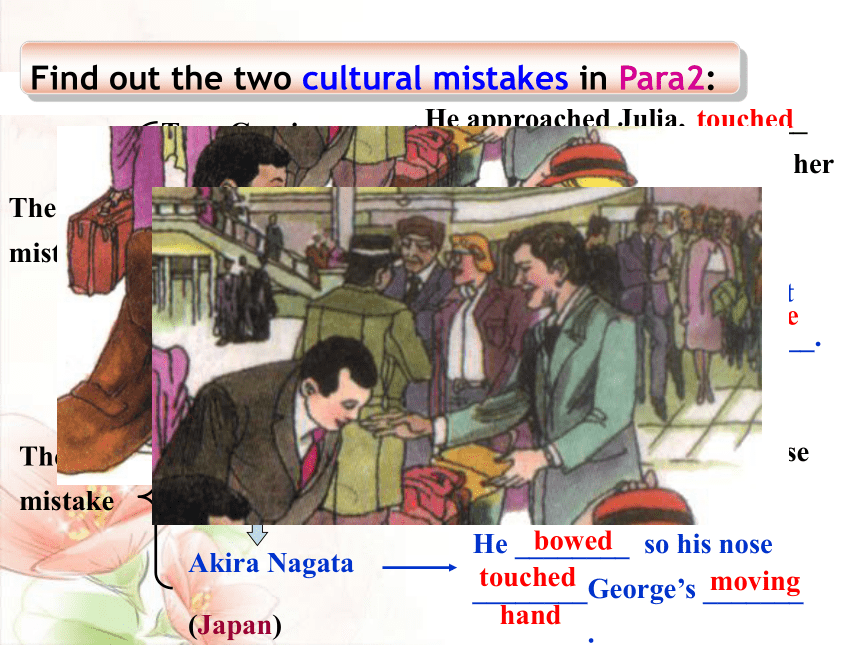
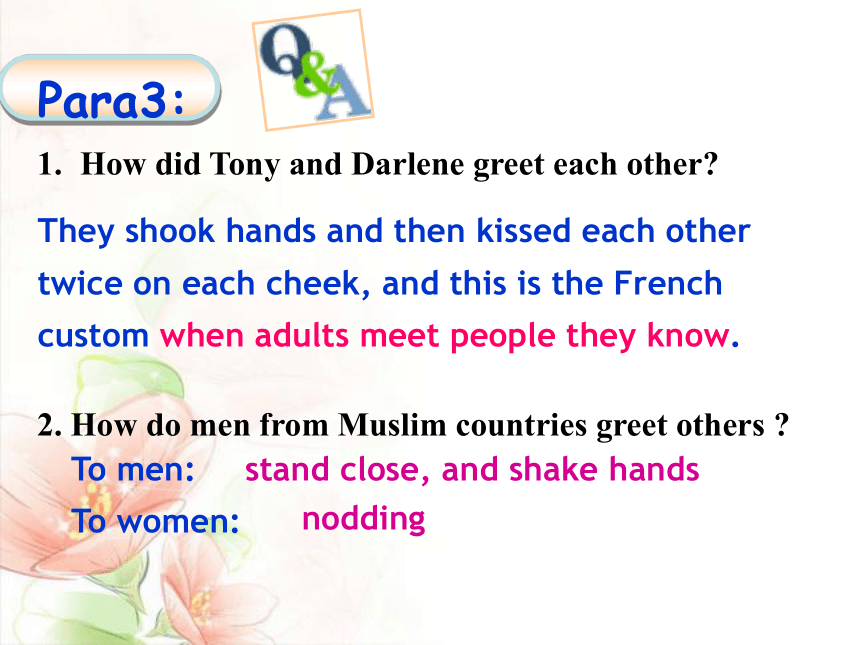
文档简介
(共37张PPT)
Body language
Unit 4
Communication:
No problem?
Reading
Predicting
Look at the picture and the title of the passage on page 26.
What do you think the topic will be?
Read the text quickly and fill in the blanks.
?????? The text introduces some examples of _____________ in greeting people to tell readers that in order to avoid difficulties we should study ____________________ in today’s world of cultural crossroads.?
Skimming
body language?
international customs
1.Who are the people mentioned in the passage?
2.Where are they from?
3.Why are the people visiting China?
people country
China
Tony Garcia
Columbia
Julia Smith
Britain
Akira Nagata
Japan
George Cook
Canada
Ahmed Aziz
Jordan
Madame Coulon
France
I
Mr Garcia
Ahmed Aziz
Julia Smith
Nagata
George
Cook
Coulon
Do all students greet each other in the same way ?
How many international students are
mentioned in the passage? Who are they?
Six students. Tony Garcia, Julia Smith,
Akira Nagata, George Cook, Ahmed Aziz, Darlene Coulon
No, they don’t.
Fast reading
Where are they from?
Mr Garcia
Ahmed Aziz
Nagata
Julia Smith
George Cook
Coulon
Jordon
Colombia
Britain
Japan
Canada
France
Read the passage and divide the
whole passage into several parts
and find out the main idea.
Scanning
Part 2 (Para. 2 and 3)
People from different countries express greetings in different ways.
Part 3. (Para. 4)
Different peoples have different body languages.
Part 4. (Para. 5)
To suggest studying international customs
Part 1. (Para. 1)
Meet the visitors at the airport.
Detailed reading : Para1
Time: __________________________
People: ______________________________
______________________________________
Place: _______________________________
What to do: ____________________________
_______________________________________
_______________________________________
yesterday
another student and I,
the Capital International Airport
this year’s international students
Went to meet international
students,and we would take them first to
their dormitories and then to the student canteen.
Find out the two cultural mistakes in Para2:
Tony Garcia
Julia Smith
The first mistake
(Columbia )
(Britain)
He approached Julia, ________ _____ _________and _______ her on the ________.
She ______ ________ appearing _________ and put up her hands, as if ___ _______.
shoulder
touched
her
kissed
cheek
stepped back
surprised
in defence
The second mistake
Akira Nagata
(Japan)
George Cook
(Canada)
He ________ his hand ________ to the Japanese student.
He ________ so his nose ________George’s _______ ________.
bowed
touched
moving
hand
reached
out
How did Tony and Darlene greet each other?
2. How do men from Muslim countries greet others ?
Para3:
They shook hands and then kissed each other twice on each cheek, and this is the French custom when adults meet people they know.
To men:
To women:
stand close, and shake hands
nodding
3. Is the main character “I” male or female? How do you know?
Male. Because Ahmed Aziz only shakes hands with men.
People in the country/area Ways to greet each other
English people
People from Spain, Italy and South American countries
Japanese
Most people around the world
_________others closely and are more likely to__________.
Do not stand _________to others or touch ________ when they meet.
Bow
Shake hands
Fill in the table according to Para4:
Read it together.
very close
strangers
Approach
touch them
Para 5:
These _______ are not good or bad, but are _____ ways ____ _______ culture have developed.
Do all members of a culture behave in the same way?
In general, studying _____________ __________ can certainly help ______ ______________ in today’s world of cultural crossroads!
No, not all members of a culture behave in the same way.
international customs
avoid difficulties
actions
simply
in which
How do different international
students behave when they greet
people? Complete the chart with
information from the passage.
Careful reading
Name Description Body Language To Whom
Tony Garcia everyone
no touching
man from Japan
man from Colombia
kiss on the cheek
Julia Smith
woman
from Britain
everyone
Akira Nagata
bowing
everyone
Name Description Body Language To Whom
George Cook
to men
to women
shake hands and kiss twice on each cheek
man from Canada
shaking hands
everyone
Ahmed Aziz
man from Jordan
shaking hands
nodding
Darlene Coulon
woman from France
people she knows
Country/Area Ways to greet each other
Britain
Canada
Japan
shake hands, do not stand very close to others or touch strangers when they meet
shake hands
bow
Spain, Italy, South American countries
France
approach others closely
and are more likely to
touch them
shake hands and kiss each other twice on each cheek
(men from) Middle East and other Muslim cultures
shake hands and stand quite close to other men, nod to women and do not shake hands with them
●Read the last paragraph and have a discussion : 1.What does the following sentence mean? None of these actions is either good or bad. 2. When in Rome, do as the Romes do.
Body language varies from culture to culture. Not all members of all cultures behave the same way, so there is no standard to judge which culture is good or bad. Instead we should try to master and respect each other’s culture in order to make good communication.
“When in Rome, do as the Romans do.”
This saying means that when we are in a certain place, we should follow the customs of the people who live in that place, not our own customs.
入乡随俗
1. When the Chinese meet, they shake hands. So do the Japanese.
2. The American like touching each other when they meet.
3. Englishmen often stand close to others or touch strangers as soon as they meet.
4. Most people around the world now greet each other by shaking hands .
Read the text carefully,
then decide if they are true (T) or false (F).
5.Not all cultures greet each other the same way, nor are they comfortable touching strangers or being too close or too far away.
6.People from Jordan will shake hands with a woman as she introduces herself to them.
7.Body language in some countries is good while some in others is bad.
8. French people usually shake hands and kiss each other twice on each cheek when they meet.
Who seemed to prefer to keep more physical distance from others? Who seemed to prefer closer physical distance?
The British woman, Julia, and probably the Canadian man, George, seemed to prefer to keep more physical distance from others. The Colombian man, Tony, and the Jordanian man, Ahmed, seemed to prefer closer physical distance.
Is there any students have similar greeting customs? If so, which ones?
Yes. Tony from Colombia and Darlene from France had a similar greeting custom --- a kiss.
George from Canada and Ahmed from Jordan also had a similar greeting custom --- a handshake, but Ahmed shakes hands only with men.
Body language is very important in our daily life, and it may vary from different cultures. When we are visiting other countries, we should follow their customs. That is to say, _________________________.
When in Rome, do as the Romans do.
What can you learn from this passage?
Part 5: Summary
Another student and I, ___________ (represent) our university’s student association, went to the airport 2. __________ (meet) some international students 3. __________ were coming to study at?Beijing?University. Not all people 4. _________ different cultures greet each other in 5. ________ same way. 6. __________ (have) international friends has helped me to learn more about this cultural “body language”.
representing
to meet
who
from
the
Having
People communicate with each other 7. _________ (use) spoken language as well as unspoken “language” through physical 8. _________ (distant), actions or posture. These actions are not good or bad, but are simply ways 9. _________ cultures have developed. Studying them can help us 10. _________ (avoid) difficulties in today’s global society.
using
distance
how
(to) avoid
The Maori in New Zealand touch noses to greet people.
In Vietnamese culture, only parents or a high-ranking person can touch your head.
A Bulgarian nods to mean “no” and shakes his head from side to side to mean “yes”.
……
Do you know?
Other information about Body Language:
Discussion
Body language varies from culture to culture.
Gesture Country Meaning
eye contact some countries
other countries
show interest
rude or
disrespectful
Gesture Country Meaning
a circle with one’s thumb and index finger most countries
Japan
France
Germany
Brazil
zero
rude
money
OK
Gesture Country Meaning
thumbs up the US
Nigeria
Germany
Japan
No.1
rude
great / good job
Gestures countries Meaning
Shaking one’s hand
Bulgaria, parts
of Greece, Iran
Other countries
No
Yes
Gestures countries Meanings
Kiss on the
cheek
A firm
handshake
A loving hug
A bow / a nod
of head
Greet
friends
France
Russia
Other countries
Talk about body languages you usually use.
Homework
Body language
Unit 4
Communication:
No problem?
Reading
Predicting
Look at the picture and the title of the passage on page 26.
What do you think the topic will be?
Read the text quickly and fill in the blanks.
?????? The text introduces some examples of _____________ in greeting people to tell readers that in order to avoid difficulties we should study ____________________ in today’s world of cultural crossroads.?
Skimming
body language?
international customs
1.Who are the people mentioned in the passage?
2.Where are they from?
3.Why are the people visiting China?
people country
China
Tony Garcia
Columbia
Julia Smith
Britain
Akira Nagata
Japan
George Cook
Canada
Ahmed Aziz
Jordan
Madame Coulon
France
I
Mr Garcia
Ahmed Aziz
Julia Smith
Nagata
George
Cook
Coulon
Do all students greet each other in the same way ?
How many international students are
mentioned in the passage? Who are they?
Six students. Tony Garcia, Julia Smith,
Akira Nagata, George Cook, Ahmed Aziz, Darlene Coulon
No, they don’t.
Fast reading
Where are they from?
Mr Garcia
Ahmed Aziz
Nagata
Julia Smith
George Cook
Coulon
Jordon
Colombia
Britain
Japan
Canada
France
Read the passage and divide the
whole passage into several parts
and find out the main idea.
Scanning
Part 2 (Para. 2 and 3)
People from different countries express greetings in different ways.
Part 3. (Para. 4)
Different peoples have different body languages.
Part 4. (Para. 5)
To suggest studying international customs
Part 1. (Para. 1)
Meet the visitors at the airport.
Detailed reading : Para1
Time: __________________________
People: ______________________________
______________________________________
Place: _______________________________
What to do: ____________________________
_______________________________________
_______________________________________
yesterday
another student and I,
the Capital International Airport
this year’s international students
Went to meet international
students,and we would take them first to
their dormitories and then to the student canteen.
Find out the two cultural mistakes in Para2:
Tony Garcia
Julia Smith
The first mistake
(Columbia )
(Britain)
He approached Julia, ________ _____ _________and _______ her on the ________.
She ______ ________ appearing _________ and put up her hands, as if ___ _______.
shoulder
touched
her
kissed
cheek
stepped back
surprised
in defence
The second mistake
Akira Nagata
(Japan)
George Cook
(Canada)
He ________ his hand ________ to the Japanese student.
He ________ so his nose ________George’s _______ ________.
bowed
touched
moving
hand
reached
out
How did Tony and Darlene greet each other?
2. How do men from Muslim countries greet others ?
Para3:
They shook hands and then kissed each other twice on each cheek, and this is the French custom when adults meet people they know.
To men:
To women:
stand close, and shake hands
nodding
3. Is the main character “I” male or female? How do you know?
Male. Because Ahmed Aziz only shakes hands with men.
People in the country/area Ways to greet each other
English people
People from Spain, Italy and South American countries
Japanese
Most people around the world
_________others closely and are more likely to__________.
Do not stand _________to others or touch ________ when they meet.
Bow
Shake hands
Fill in the table according to Para4:
Read it together.
very close
strangers
Approach
touch them
Para 5:
These _______ are not good or bad, but are _____ ways ____ _______ culture have developed.
Do all members of a culture behave in the same way?
In general, studying _____________ __________ can certainly help ______ ______________ in today’s world of cultural crossroads!
No, not all members of a culture behave in the same way.
international customs
avoid difficulties
actions
simply
in which
How do different international
students behave when they greet
people? Complete the chart with
information from the passage.
Careful reading
Name Description Body Language To Whom
Tony Garcia everyone
no touching
man from Japan
man from Colombia
kiss on the cheek
Julia Smith
woman
from Britain
everyone
Akira Nagata
bowing
everyone
Name Description Body Language To Whom
George Cook
to men
to women
shake hands and kiss twice on each cheek
man from Canada
shaking hands
everyone
Ahmed Aziz
man from Jordan
shaking hands
nodding
Darlene Coulon
woman from France
people she knows
Country/Area Ways to greet each other
Britain
Canada
Japan
shake hands, do not stand very close to others or touch strangers when they meet
shake hands
bow
Spain, Italy, South American countries
France
approach others closely
and are more likely to
touch them
shake hands and kiss each other twice on each cheek
(men from) Middle East and other Muslim cultures
shake hands and stand quite close to other men, nod to women and do not shake hands with them
●Read the last paragraph and have a discussion : 1.What does the following sentence mean? None of these actions is either good or bad. 2. When in Rome, do as the Romes do.
Body language varies from culture to culture. Not all members of all cultures behave the same way, so there is no standard to judge which culture is good or bad. Instead we should try to master and respect each other’s culture in order to make good communication.
“When in Rome, do as the Romans do.”
This saying means that when we are in a certain place, we should follow the customs of the people who live in that place, not our own customs.
入乡随俗
1. When the Chinese meet, they shake hands. So do the Japanese.
2. The American like touching each other when they meet.
3. Englishmen often stand close to others or touch strangers as soon as they meet.
4. Most people around the world now greet each other by shaking hands .
Read the text carefully,
then decide if they are true (T) or false (F).
5.Not all cultures greet each other the same way, nor are they comfortable touching strangers or being too close or too far away.
6.People from Jordan will shake hands with a woman as she introduces herself to them.
7.Body language in some countries is good while some in others is bad.
8. French people usually shake hands and kiss each other twice on each cheek when they meet.
Who seemed to prefer to keep more physical distance from others? Who seemed to prefer closer physical distance?
The British woman, Julia, and probably the Canadian man, George, seemed to prefer to keep more physical distance from others. The Colombian man, Tony, and the Jordanian man, Ahmed, seemed to prefer closer physical distance.
Is there any students have similar greeting customs? If so, which ones?
Yes. Tony from Colombia and Darlene from France had a similar greeting custom --- a kiss.
George from Canada and Ahmed from Jordan also had a similar greeting custom --- a handshake, but Ahmed shakes hands only with men.
Body language is very important in our daily life, and it may vary from different cultures. When we are visiting other countries, we should follow their customs. That is to say, _________________________.
When in Rome, do as the Romans do.
What can you learn from this passage?
Part 5: Summary
Another student and I, ___________ (represent) our university’s student association, went to the airport 2. __________ (meet) some international students 3. __________ were coming to study at?Beijing?University. Not all people 4. _________ different cultures greet each other in 5. ________ same way. 6. __________ (have) international friends has helped me to learn more about this cultural “body language”.
representing
to meet
who
from
the
Having
People communicate with each other 7. _________ (use) spoken language as well as unspoken “language” through physical 8. _________ (distant), actions or posture. These actions are not good or bad, but are simply ways 9. _________ cultures have developed. Studying them can help us 10. _________ (avoid) difficulties in today’s global society.
using
distance
how
(to) avoid
The Maori in New Zealand touch noses to greet people.
In Vietnamese culture, only parents or a high-ranking person can touch your head.
A Bulgarian nods to mean “no” and shakes his head from side to side to mean “yes”.
……
Do you know?
Other information about Body Language:
Discussion
Body language varies from culture to culture.
Gesture Country Meaning
eye contact some countries
other countries
show interest
rude or
disrespectful
Gesture Country Meaning
a circle with one’s thumb and index finger most countries
Japan
France
Germany
Brazil
zero
rude
money
OK
Gesture Country Meaning
thumbs up the US
Nigeria
Germany
Japan
No.1
rude
great / good job
Gestures countries Meaning
Shaking one’s hand
Bulgaria, parts
of Greece, Iran
Other countries
No
Yes
Gestures countries Meanings
Kiss on the
cheek
A firm
handshake
A loving hug
A bow / a nod
of head
Greet
friends
France
Russia
Other countries
Talk about body languages you usually use.
Homework
同课章节目录
